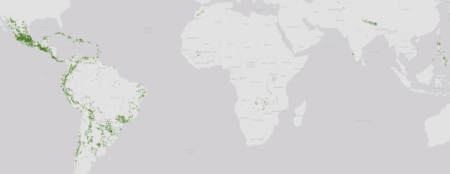- A cool apple museum in Wenatchee, Washington.
- Cool museum exhibit on German colonial exploitation of agricultural raw materials, in Hamburg.
- Mohawk culture and teaching embodied in seeds. And not in a museum.
- Indian legumes a hit in Ghana, via genebanks, not museums.
- Long video from IPK on using data to use genebanks. You mean like above?
Nibbles: Wheat Revolutions, Animal domestication, Sanbokan, Sea Island heirlooms, No regrets transformation, Peruvian smallholders, Seed systems book, Genebank vid, Business
- BBC Food Programme on wheat, with the authors of Amber Waves and The Man Who Tried to Feed the World.
- Tides of History podcast on livestock domestication with Prof. Greger Larson. He thinks “domestication” should be used as a descriptor of a state rather than a label for a process. He also thinks that animals became “domesticated” basically only once (except for pigs).
- A citrus fruit you never heard of is crucial to Japanese cuisine.
- Bringing back heirloom rice and other traditional crops in the Sea Islands. And more.
- Building back better: from 200 food systems recommendation to 41 no regrets actions. And why we need them NOW!
- A Peruvian peasant organization goes digital.
- Huge book on strengthening seed systems in South Asia.
- Nice CGN video on seed processing in genebanks.
- How can businesses value biodiversity? Here come the guidelines.
The fun begins for the amazing Denise Costich
Another transition at an international genebank. Dr Denise Costich, head of the CIMMYT maize genebank, is retiring. Here’s what they call her “exit seminar.”
Denise and her team kept 32,000 accessions safe, and made them available to all. Denise is moving on, but that work continues.
Happy retirement, Denise!
Nibbles: Costich leaving seminar, Dibble video, AnGR plan, Building back better
- Dr Denise Costich says goodbye to the CIMMYT maize genebank. Sad.
- Dr Flint Dibble talks to himself about his Neolithic package.
- Europe’s plan for conserving transboundary livestock breeds.
- How are genebanks doing in the pandemic?
Nibbles: Artocarpus, Malus, Citrullus, spp, Asimina, Daucus
- The colonial history of the jackfruit in Sri Lanka.
- “…some of the best cider you can drink is as funky and wild as a 1970s Berlin bathhouse.” Ok, you twisted my arm.
- The world in a Philadelphia watermelon stand.
- Bee Wilson’s review of wheat book Amber Waves by Catherine Zabinski.
- The Canadian genebank at 50.
- Oh shoot I missed National Pawpaw Day.
- Podcast on carrot breeding using crop wild relatives.
